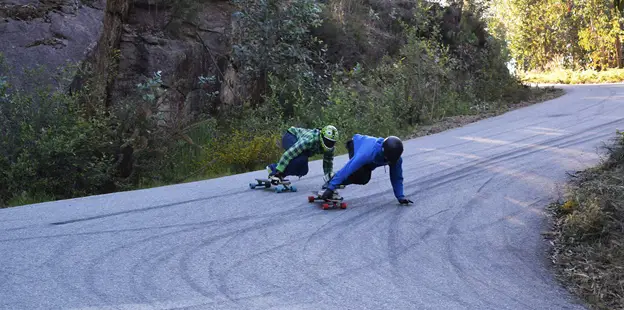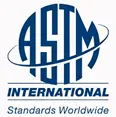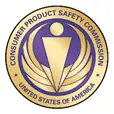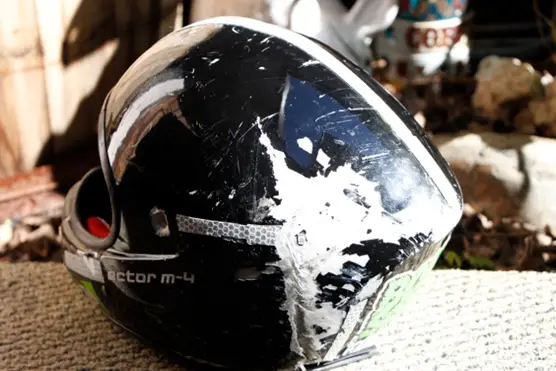Helmets are no brainers
If there’s something you should never skip looking over and spending good money on, it’s safety gear. Unlike street and park skaters, the longboard community as a whole encourages the use of helmets and other safety gear as needed. You won’t be uncool for wearing a helmet, in fact the likely thing to happen is that other riders will look down on you for refusing to use one.
» See what we chose as the best longboarding helmets
How dangerous is longboarding?
That’s a very open question and it’s not only defined to the style of riding and to how alert, knowledgeable and cautious the rider is. Riders tend to be less prone to getting small scratches from falling because a pebble caught a wheel, but injuries from landing tricks incorrectly are just as common as street or park skating. For freeride and downhill injuries can be more common when the rider is less experienced, that’s why safety gear is highly encouraged in those modalities. Eventually, as the rider becomes more experienced, leaving sessions without a scratch won’t be out of the norm. Tell your concerned parent all you need is safety gear in good conditions and some patience.

What the deal with certifications? It sounds complicated
It’s not. Certifications assure you your helmet wont fail you when you need it the most; there’s no way to know when you will fall and hit your head hard. If it hasn’t happened to you, you probably haven’t been skating long enough. Apart from their odd number and letter names, certifications are fairly easy to understand.
The most common certifications used in skate and longboard helmets are CE, ASTM and CPSC. It’s just three, you have no excuse to not know them.
CE standards

CE markings indicates the helmet meets the required standards in the European Economic Community Directive. The directive is mandatory, so all helmets must be CE certified if they’re to be sold in Europe. Look for the following certification:
- EN CE 1078 for bicycle helmets
ASTM standards

ASTM International is an organization comprised of thousands of skilled volunteers including doctors, engineers and physicists. ASTM sets safety standard for many types of safety equipment, it’s quite common for protective sports gear to be ASTM certified in the US. Look for the following certifications:
- ASTM F1492 for skateboard helmets
- ASTM F1447 for bicycle helmets
- ASTM F1952 for downhill mountain bike helmets
CPSC standards

CPSC sets bicycle helmet safety standards. All helmets sold as bicycle helmets sold in the US must meet CPSC safety standards.
The bare minimum
The bare minimum is to at least be certified. The weakest certification a helmet should have is ATSM F1492 for skateboard helmets.
The hard black foam inside a helmet is called expanded polystyrene or EPS. EPS absorbs the majority of impact force should a fall happen, so it’s important to know that it will hold up and it’s not just some cheap copy. Make sure the EPS is certified by CPSC standards. The EPS being certified doesn’t necessarily mean the helmet is, so watch out for that.
Buy helmets from known brands, trying to cheap out on helmets is a terrible mistake. Unlike other parts of your body, you only have one head – and the rest of your body can’t function without it. Do what you must to protect it.
Certified, certified, certified
Most skate helmets are certified for skateboarding; seems logical, but for some styles of longboarding falls can be quite more unforgiving and more safety is needed. While having a certification for skateboards for dancing, freestyle or LDP, for faster riding it’s better to look at bicycle certifications since they’re held to a higher standard.
For example: an F1952 certification for downhill mountain bike helmets is held to a higher standard than F1447 for skateboard helmets. If you plan on going faster, an F1952 certification assure a lot more safety.
CPSC only cover bicycle certifications. A dual certified helmet with CPSC is bound to withstand whatever you throw at it.

Editor’s note: my own half shell is CE and CPSC certified. It’s taken countless small falls and hits, but still no sign of real damage. For faster riding I use a full face helmet.
Full face helmets are also a good option for advanced riders since they offer full protection to the face and sides of the head. Full face helmets are not cheap but it is a necessary piece of equipment for any serious downhill and freeride rider. Always make sure to buy full faces from known and trusted longboard brands; snowboard, dirt bike or motorcycle helmets are not designed for the visibility and safety needed for skating downhill and the weight can be a hazard.
When should I buy a new longboarding helmet?
Helmets usually take a lot of abuse to break, but you shouldn’t wait for it to be completely destroyed before getting a new one.
If abrasion from the road has worn the outer hard shell to expose the EPS or the inner shell, it’s time to get a new helmet. A helmet in this state is incredibly dangerous and you’ll want to change your it well before it gets to this state.

A fall resulting in direct impact to the head can result in a concussion even with a helmet on – the difference is that most of the time you might get a small headache instead of fracturing your skull. Direct hits can cause the shell to crack of the EPS foam to rip, a helmet in those conditions is very dangerous to use and won’t protect the head to its intended capability. For this reason, helmets should always be one-hit only; after taking a direct hit you should always replace it.
What are aerolids?
If you’ve been skating for a while you might have heard of, or even seen, aerolids. Aerolids are full face helmets with fairings for greater aerodynamics.

Most of the time, aerolids lack chin protection which makes them not as safe as other full face helmets. Aerolids are only for professionals; they’re not meant to take abuse and are completely out of price range for most intermediate to experienced riders. They’re not rare to see at more known downhill events and IDF races.
Even more
Learn more about skate safety at Skatesafe. They have excellent information on everything safety related. This chart displays most helmets on the market and what certification they have.
Always remember to buckle your helmet and be safe out there, skating is a lot more fun when you don’t hurt yourself too often.







